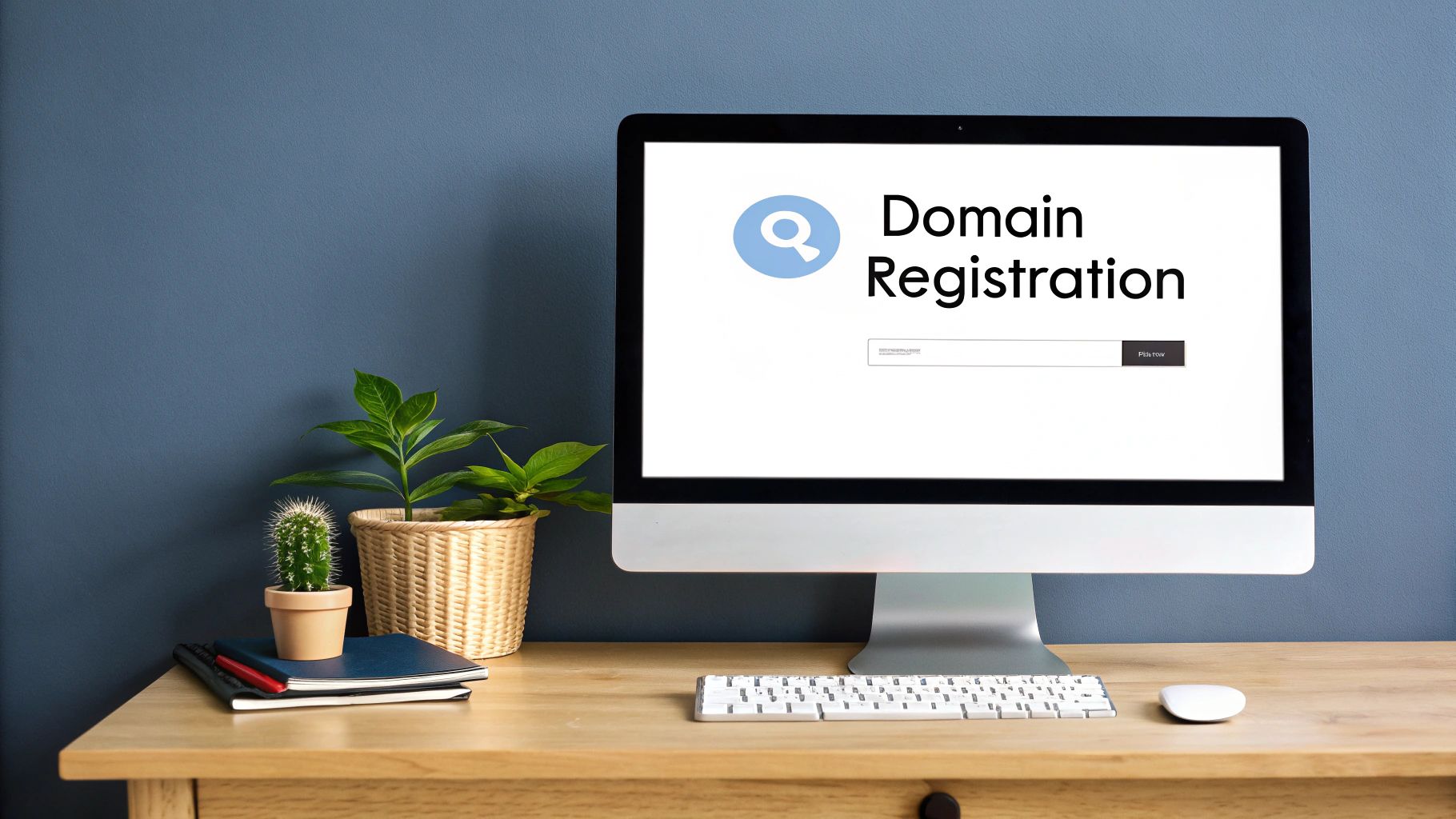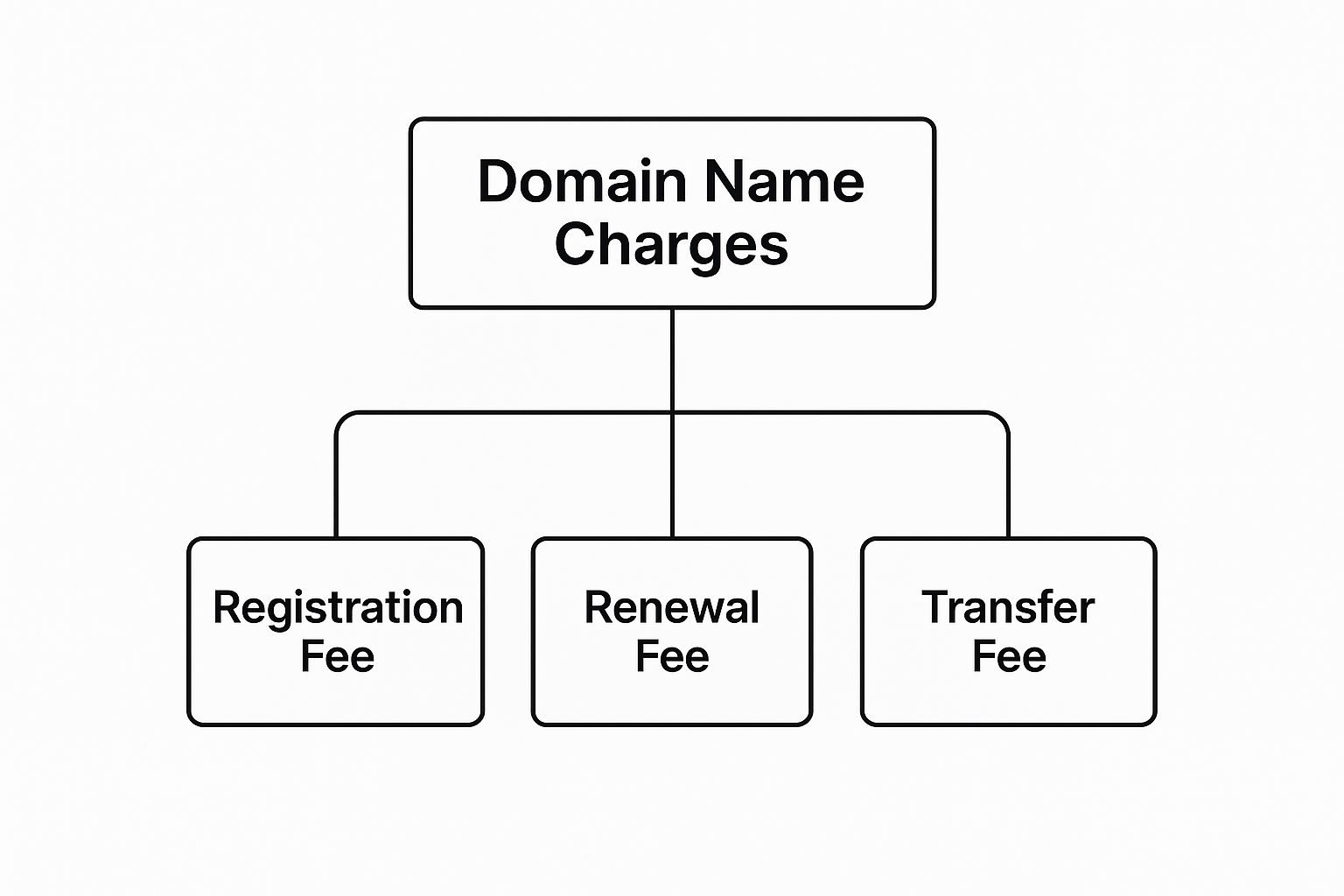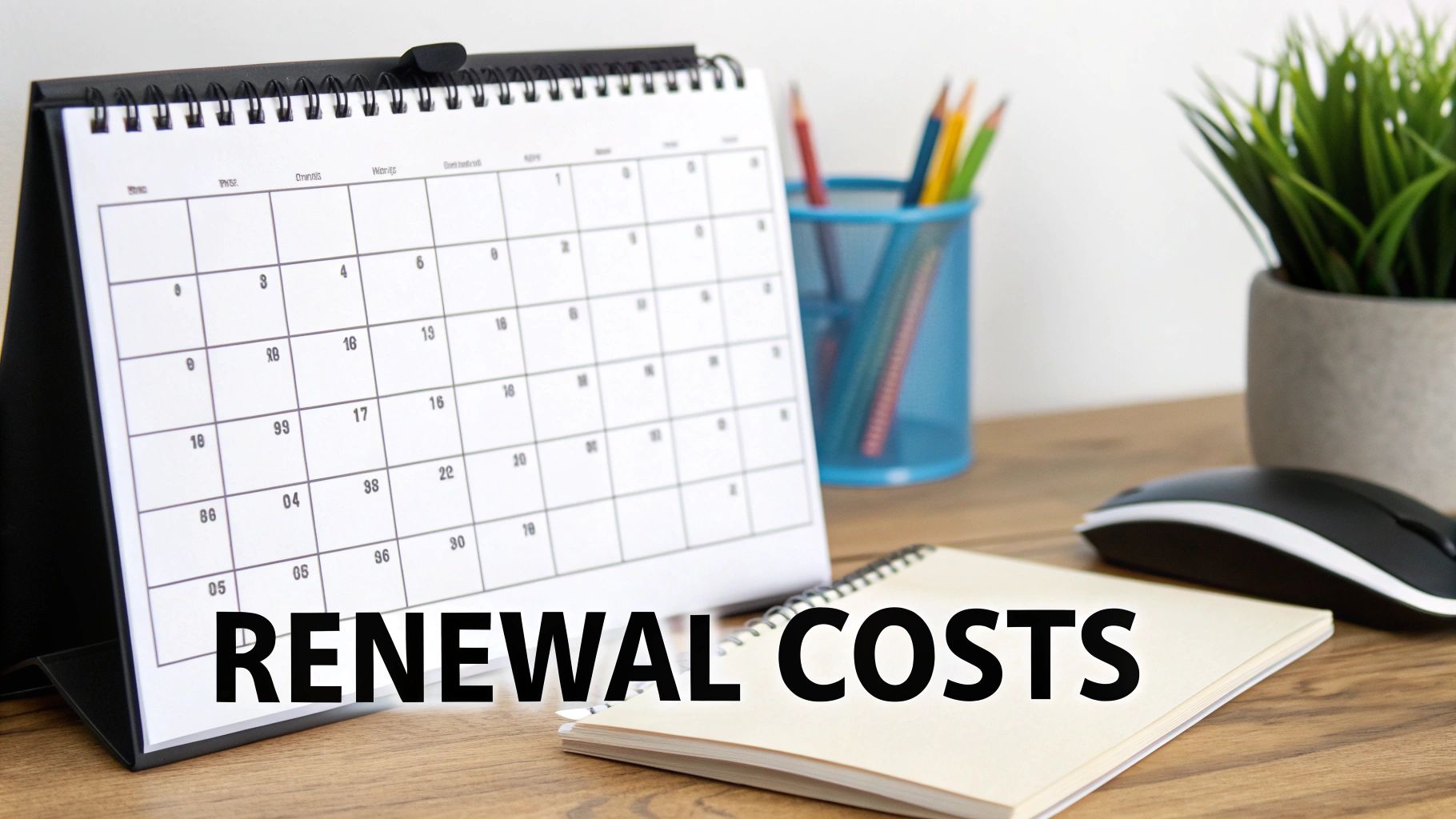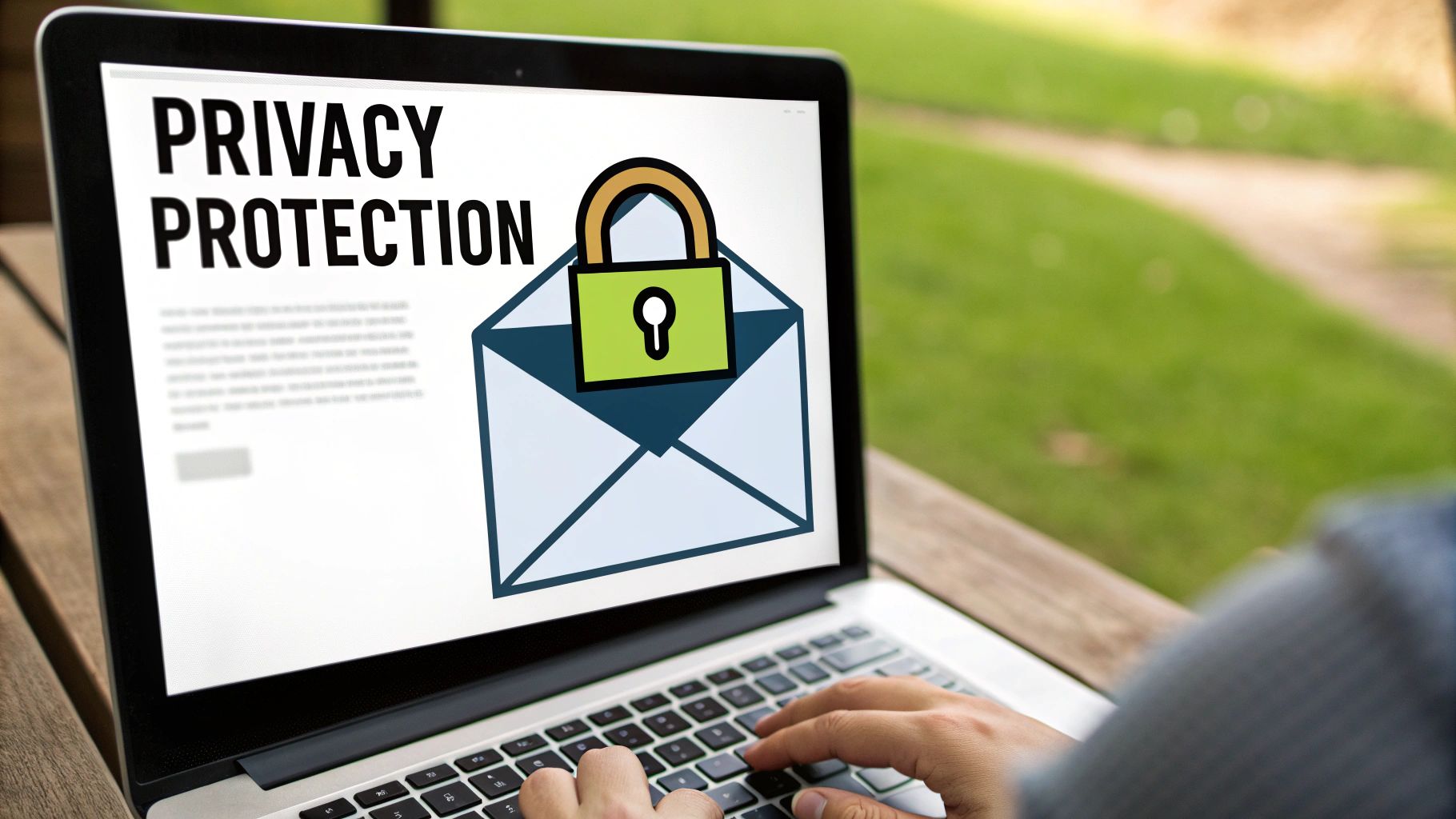When you start your search for the perfect domain name, it's easy to get drawn in by those eye-catching low prices. A few dollars for your own piece of the internet? It seems like a bargain. But that initial price tag is just the start of the story.
Think of it like buying a car. The sticker price gets you in the door, but it doesn't cover insurance, registration, or fuel. The same principle applies to your domain name—the total cost of ownership is more than just that first payment.
Understanding the True Cost of Your Domain

That appealing low price is almost always a first-year promotional deal. It's a marketing tactic designed to get you signed up. The real domain name charges appear later, which is why it’s crucial to understand the complete cost structure right from the start.
Owning a domain isn't a one-time purchase. It’s more like leasing a digital address, and there are ongoing fees to keep it yours. Just as you’d pay council rates on a physical property, your domain requires upkeep costs to maintain your ownership. Getting a handle on these fees helps you budget properly and avoid any unpleasant surprises down the road.
Breaking Down the Main Charges
So, what are you actually paying for? The total cost of a domain is usually made up of a few distinct parts. Once you know what they are, you can make a much smarter investment in your online brand.
Here are the key components you'll almost always encounter:
- Initial Registration Fee: This is the upfront cost to secure your domain for the first year. It's often heavily discounted to attract new customers.
- Annual Renewal Fee: This is the recurring charge you'll pay each year to keep your domain active. Surprise! It's usually significantly higher than the initial registration price.
- Optional Add-Ons: These are extra services you can add to your purchase. The most common is domain privacy, which prevents your personal contact details from being listed in a public database.
A great way to think about it is like buying digital real estate. The initial registration is your down payment. The annual renewal fees are your property taxes, and add-ons like privacy are your home insurance—not mandatory, but definitely a wise investment for peace of mind.
Once you learn to look past the flashy first-year deals, you'll be in a much better position to plan for the true, long-term costs of building your brand online.
Let's look under the hood and see what really makes up your domain name bill. No matter who you register with, every invoice is built on a few core components. You'll always see two main items: the initial registration fee and the ongoing renewal fee.
Think of the registration fee like the drive-away price for a new car—it’s usually a tempting, low number designed to get you in the door. The renewal fee, however, is the real cost of keeping it on the road year after year. This is where many people get caught by the classic ‘first-year discount’ trap, snagging a cheap entry price only to see it jump up significantly when it's time to renew.
This visual gives you a quick breakdown of the main fees you'll come across when managing a domain.

As you can see, it's those three key costs—registration, renewal, and transfers—that form the foundation of your total domain bill.
Registration vs Renewal Costs
So, why the price difference? It all comes down to how the industry is structured. A domain registry (think of them as the wholesaler) sets a base price, and your registrar (the retailer, like us at Hostingtap) adds their own markup. Here in Australia, for example, the governing body auDA sets the rules for all .au domains. The direct registry fee for a .com.au domain has historically sat around AUD 10 to AUD 15 per year.
But with a registrar's markup for services and support, the price you actually pay can end up anywhere from AUD 15 to AUD 40 annually. It’s a standard retail model, just for digital real estate. You can get a deeper look into the numbers by checking out auDA's public registry reports.
To give you a clearer picture, here's how those annual costs typically stack up for a standard .com.au domain.
Typical Breakdown of Annual Domain Costs
| Cost Component | Typical Price Range (AUD) | Description |
|---|---|---|
| Base Registration/Renewal Fee | $15 – $25 | The core annual cost to keep the domain registered in your name. |
| ICANN Fee | $0.18 – $0.25 | A small, mandatory fee that goes to the Internet Corporation for Assigned Names and Numbers. |
| WHOIS Privacy Protection | $5 – $15 | An optional add-on that hides your personal contact details from public view. |
| Total Annual Cost | $20 – $40+ | The combined total you can expect to pay each year for a standard domain with privacy. |
This table shows that while the base fee is the biggest part of the bill, those little add-ons can start to push the final price up.
Understanding this distinction is the key to forecasting your website's long-term budget. A cheap first year is great, but the renewal cost is what truly defines your ongoing expense.
This is exactly why registering for multiple years upfront can be a savvy move. It locks in that initial price and shields you from any future price hikes. Just as important is knowing your renewal date to avoid any nasty surprises. We've got a helpful guide on how to check when your domain expires that makes it easy. A little planning goes a long way in keeping your budget on track.
Decoding Hidden Fees and Optional Add-Ons

While registration and renewal are the main events, the smaller, optional domain name charges are where your bill can unexpectedly grow. These extras often pop up during checkout, and knowing which ones are essential versus which are simple upsells is key to managing your budget.
Many of these add-ons are designed to boost your security or simplify management, but they aren't always necessary for everyone. Let's shine a light on the most common extras so you can make an informed choice.
Essential Add-Ons Worth Considering
One of the most valuable extras you’ll encounter is WHOIS privacy protection. When you register a domain, your personal details—name, address, email—are typically published in a public database. WHOIS privacy shields this information, replacing it with the registrar's details to protect you from spammers and unwanted contact.
Another common charge is the domain transfer fee. If you decide to move your domain from one registrar to another, there's often a small administrative cost involved. While it’s not a recurring expense, it’s an important one to be aware of. For a detailed walkthrough, you can learn more about how to transfer your domain name in our guide.
Think of WHOIS privacy as getting a private letterbox for your digital address. Instead of your personal mail being left on the footpath for anyone to see, it’s securely held and forwarded, keeping your identity safe.
Fees That Catch You Unprepared
Some charges only appear when things go wrong. If your domain expires, it enters a grace period where you can renew it at the standard price. Miss that window, and it falls into a redemption period, where recovering it can cost upwards of $100 or more. It's a painful and easily avoidable expense.
Finally, keep an eye on automatic renewals. While convenient, they can lead to you paying for domains you no longer need. It’s always smart to periodically review your domain portfolio and turn off auto-renew for any you plan to let go. This simple check can prevent surprise charges from appearing on your credit card.
Why Premium Domains Cost More
You've probably noticed that not all domain names are priced equally. Some come with a seriously hefty price tag—these are what we call premium domains. Think of them as the digital equivalent of prime real estate. A storefront on a bustling main street is always going to cost more than one tucked away in a quiet suburb, and it’s the same principle online.
A short, memorable, or keyword-rich domain like cars.com.au is far more valuable than something long and clunky. It's instantly recognisable and easy for customers to remember, giving its owner a massive branding advantage from day one. This built-in value is exactly why the initial purchase price can skyrocket into the thousands, or sometimes, even millions of dollars.
The True Cost of Premium Ownership
But the high initial fee is only one piece of the puzzle when it comes to the total domain name charges for a premium address. What often catches people by surprise is that the annual renewal fee can also be massively inflated, sometimes costing hundreds or even thousands of dollars every single year. This detail is critical because it turns a one-time purchase into a significant, recurring operational expense.
A premium domain isn't just a name; it's a strategic business asset. The price reflects its potential to drive direct traffic, improve brand recall, and establish authority in a competitive market.
Before you commit to that perfect premium domain, it's absolutely essential to understand this long-term financial obligation. The higher renewal cost is set by the registry—it’s not something you can negotiate—so you have to factor it into your annual budget. While the benefits of a premium name can be immense, the total cost of ownership has to make sense for your business strategy to ensure it's a sustainable investment for your brand's future. A little foresight here can save you from a nasty financial shock down the line.
How Australian Domain Charges Compare Globally

When you’re weighing up domain name charges, it’s helpful to zoom out and see where Australia stands on the world stage. The local domain landscape is quite unique, thanks largely to the steady hand of auDA (the .au Domain Administration). They’ve cultivated a remarkably stable and predictable pricing environment for .au domains.
This local stability is a world away from the often-volatile international market. Consider legacy domains like .com, where wholesale prices have been creeping up consistently. In fact, industry reports show the wholesale cost for .com registrations jumped by around 28% between 2021 and 2024. Naturally, those increases get passed straight on to you, the customer.
Why Australian Domains Offer Predictable Value
So, what’s the secret sauce? It comes down to regulation and a sharp local focus. The .au domain space is managed with Australian interests at heart, which helps insulate it from the wild price swings we see with more generic, global TLDs.
For Australian businesses, this homegrown approach delivers serious perks:
- Stable Pricing: Unlike .com, which is at the mercy of global market forces, .au pricing isn’t prone to sudden, eye-watering hikes.
- Clear Eligibility Rules: You need a verified Australian presence to register a .com.au domain, which keeps the namespace relevant and valuable for local businesses.
- Customer Trust: Seeing an .au address is an instant signal for customers that your business is local, building all-important trust and credibility.
Choosing an .au domain is like buying produce from a local farmer instead of a global supermarket. You get predictable quality and pricing, and you support the local ecosystem, all while signalling to your customers that you're part of their community.
This local focus makes the total cost of owning an .au domain much more predictable in the long run. While the upfront registration fee might look similar to a .com, the consistency in renewal fees can make it a far savvier financial move over time. Of course, the right move always comes down to finding the best domain name registrar that provides transparent pricing and the support you actually need.
Smart Strategies to Minimise Your Domain Costs
Knowing what you’re paying for is one thing, but actively managing those costs is how you truly save money. With a few clever tactics, you can significantly cut down your long-term expenses without compromising your brand's online home.
One of the simplest and most effective strategies is to register your domain for multiple years upfront. Yes, it’s a bigger payment at the start, but doing this locks in the current price. That means you’re protected from the annual price hikes that sneak up on so many people. Plus, most registrars offer a discount for the long-term commitment, so you save money right away.
Bundle and Save on Your Services
Another great way to keep costs down is to bundle your domain with a web hosting package. Hosting providers often give you a free domain for the first year when you sign up for one of their plans. It’s a fantastic deal that not only saves you money initially but also keeps your billing and management all in one place. Just make sure you check the renewal rates for both services so you know what the cost will look like down the track.
While most .au domains follow a one-year licence cycle, their renewal rates often jump by more than 70%. Registrars frequently package these with other services, which can push the total annual cost to between AUD 30 and AUD 50. You can dig into more Australian domain statistics on domainnamestat.com.
Be critical of those super-low introductory offers. A tempting $2 deal for the first year can easily balloon into a $30 annual renewal fee. Always, always compare the long-term renewal price—not just the initial discount—to see what you're really signing up for.
Finally, get organised with your domain portfolio. If you have domains you're no longer using, switch off automatic renewal. There’s no point paying for digital real estate you’ve already abandoned. For the domains you do keep, staying on top of things is key. Our guide offers more practical tips on how to renew a domain name without any of that last-minute panic.
Common Questions About Domain Costs
Domain name costs can seem confusing at first, but once you understand how the industry works, it all starts to make sense. Here are some quick answers to the questions we hear all the time.
Why Is My Domain Renewal More Expensive?
This is probably the most common surprise for new domain owners. Most registrars attract customers with a very low introductory price for the first year. That much higher price you see for renewal is actually the standard, ongoing annual cost.
It's a classic marketing tactic. Always check the renewal fee before you buy a domain so you know the full long-term cost.
Do I Have to Pay for Domain Privacy Protection?
Domain privacy, also known as WHOIS protection, is an optional add-on. It's designed to hide your personal contact details (like your name, address, and phone number) from a public database that anyone can look up. This simple step can drastically cut down on spam and enhance your personal security.
While it’s not mandatory, we strongly recommend it. The small annual fee is well worth the peace of mind.
Think of it like this: skipping privacy protection is like putting your home address and phone number in a public phone book for the whole world to see.
Can I Negotiate the Price of a Premium Domain?
It really depends on who's selling it. If a premium domain is owned by a private seller and listed on an aftermarket site, you might have some room to negotiate. It never hurts to make an offer.
However, if the domain is a premium name being sold directly by the registry (the organisation that manages the extension, like .com or .au), the price is almost always fixed.
What Happens If I Forget to Pay My Domain Renewal?
If you miss the renewal date, don't panic just yet. Your domain will enter a grace period, which is often around 30 days. During this time, you can still renew it at the normal price.
After the grace period, things get expensive. The domain enters a 'redemption period,' and renewing it can cost a small fortune. If you still don't act, the domain is eventually released back to the public, and anyone can register it. Set up auto-renewal to avoid this headache!
Ready to secure your perfect domain with clear, upfront pricing? At Hosting Tap, we make it easy to register your name, set up professional hosting, and get your business online without any hidden fees.
Find your ideal domain name and get started today at https://hostingtap.com






[…] you evaluate the various domain name charges, the return on investment in credibility and security is […]
[…] a deeper dive into all the small costs tied to your web address, this guide to decoding domain name charges is a great […]
[…] name. If you're starting from scratch, it’s worth getting your head around the different domain name charges and how they slot into your overall […]
[…] fees. To get a better handle on all the potential expenses involved, you can learn more about how domain name charges factor into your total website cost. By investing just a little more upfront, you end up getting far greater value and steering clear […]